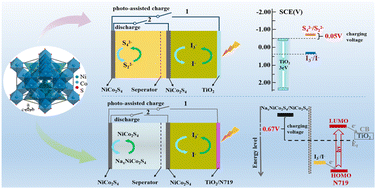Dual-duty NiCo2S4 nanosheet-based solar rechargeable batteries toward multi-scene solar energy conversion and storage†
Abstract
Solar energy has the potential to be the next-generation power source if the intermittent nature can be overcome via rational energy storage engineering. The competitiveness of solar rechargeable batteries can be further enhanced if the demand for multiple energy storage scenarios can be met within one device. Moreover, active electrochemical materials with different energy storage types are the critical component of this energy storage system. In this work, dual-duty electrochemical functional materials were introduced to guide multi-scene solar energy storage device design and fabrication. Furthermore, dual-duty NiCo2S4 nanosheets were prepared and applied to solar rechargeable batteries. A photo-assisted aqueous polysulfide/iodide flow battery was designed and fabricated with a charging voltage as low as 0.05 V, showing the good electrocatalytic performance of NiCo2S4 nanosheets for aqueous redox couples. Moreover, the low charging voltage leads to 93.5% of input electric energy saving under one sun illumination (AM 1.5, 100 mW cm−2). On the other hand is the photo-assisted sodium-ion battery with a NiCo2S4 anode, showing a remarkably low charging voltage of 0.67 V and a high discharge medium voltage of 1.05 V. The battery can save about 67.6% of input electric energy under 1 sun illumination.



 Please wait while we load your content...
Please wait while we load your content...